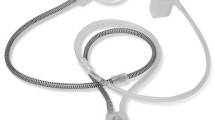Abstract
Purpose
To analyze efficacy and safety for the ZSI375 artificial urinary sphincter in a multicenter case series.
Methods
Thirteen male patients with stress urinary incontinence underwent implantation of a ZSI375 artificial urinary sphincter device between 2010 and 2012 in three international continence reference centers. Perioperative characteristics and postoperative complications were analyzed using the Clavien–Dindo scale. Re-hospitalization and explantation rates, and functional outcome were assessed. Inner-group and between-group differences were analyzed using Wilcoxon, Mann–Whitney U, and Fisher’s exact test whenever indicated. Kaplan–Meier analysis was performed to assess device survival. A p value below 0.05 was considered statistically significant.
Results
There were no intraoperative complications. Median follow-up was 13.5 months. In this period, four device defects (30.8 %) could be observed, being the main cause for device explantation, followed by device infection (15.4 %), non-resolvable pain (7.7 %), and urethral erosion (7.7 %). There were no Clavien IV or Clavien V complications. Overall explantation rate was 61.5 %. Mean time-to-explantation was 279 ± 308 days. There was no significant influence of previous irradiation and previous invasive incontinence therapy (p = 0.587 and p = 0.685, respectively). Mean daily pad usage decreased from 5.8 ± 1.5 to 2.4 ± 2.1 (p = 0.066). One patient (7.7 %) did not use any pads. Social continence (0–1 pads) was achieved in 15.4 % of the patients.
Conclusion
This is the most current study that is investigating the outcome after ZSI375 implantation in a multicenter case series. Based on our results, explantation rates after ZSI375 implantation are high and efficacy rates seem lower than previously described. Addressing this high failure rate, the system has undergone a two-step modification in the meantime.


Similar content being viewed by others
Abbreviations
- AUS:
-
Artificial urinary sphincter
- BMI:
-
Body mass index
- SUI:
-
Stress urinary incontinence
- SD:
-
Standard deviation
References
Lucas MG, Bosch RJ, Burkhard FC, Cruz F, Madden TB, Nambiar AK, Neisius A, de Ridder DJ, Tubaro A, Turner WH, Pickard RS (2012) EAU guidelines on assessment and nonsurgical management of urinary incontinence. Eur Urol 62(6):1130–1142. doi:10.1016/j.eururo.2012.08.047
Lucas MG, Bosch RJ, Burkhard FC, Cruz F, Madden TB, Nambiar AK, Neisius A, de Ridder DJ, Tubaro A, Turner WH, Pickard RS (2012) EAU guidelines on surgical treatment of urinary incontinence. Eur Urol 62(6):1118–1129. doi:10.1016/j.eururo.2012.09.023
Herschorn S (2008) The artificial urinary sphincter is the treatment of choice for post-radical prostatectomy incontinence. Can Urol Assoc J 2(5):536–539
Knight SL, Susser J, Greenwell T, Mundy AR, Craggs MD (2006) A new artificial urinary sphincter with conditional occlusion for stress urinary incontinence: preliminary clinical results. Eur Urol 50(3):574–580. doi:10.1016/j.eururo.2006.03.065
Alonso Rodriguez DFAE, Fernandez Barranco L, Vicens Vicens A GMF (2011) One hundred FlowSecure artificial urinary sphincters. Eur Urol Suppl 10:309
Dindo D, Demartines N, Clavien PA (2004) Classification of surgical complications: a new proposal with evaluation in a cohort of 6336 patients and results of a survey. Ann Surg 240(2):205–213
Staerman F, Llorens GC, Leon P, Leclerc Y (2013) ZSI 375 artificial urinary sphincter for male urinary incontinence: a preliminary study. BJU Int 111(4 Pt B):E202–E206. doi:10.1111/j.1464-410X.2012.11468.x
Van der Aa F, Drake MJ, Kasyan GR, Petrolekas A, Cornu JN (2013) The artificial urinary sphincter after a quarter of a century: a critical systematic review of its use in male non-neurogenic incontinence. Eur Urol 63(4):681–689. doi:10.1016/j.eururo.2012.11.034
Kretschmer A, Buchner A, Grabbert M, Stief CG, Pavlicek M, Bauer RM (2015) Risk factors for artificial urinary sphincter failure. World J Urol. doi:10.1007/s00345-015-1662-9
Singh G, Thomas DG (1996) Artificial urinary sphincter for post-prostatectomy incontinence. Br J Urol 77(2):248–251
O’Connor RC, Nanigian DK, Patel BN, Guralnick ML, Ellision LM, Stone AR (2007) Artificial urinary sphincter placement in elderly men. Urology 69(1):126–128. doi:10.1016/j.urology.2006.09.021
Chung E, Ranaweera M, Cartmill R (2012) Newer and novel artificial urinary sphincters (AUS): the development of alternatives to the current AUS device. BJU Int 110(Suppl 4):5–11. doi:10.1111/j.1464-410X.2012.11614.x
Sandhu JS, Maschino AC, Vickers AJ (2011) The surgical learning curve for artificial urinary sphincter procedures compared to typical surgeon experience. Eur Urol 60(6):1285–1290. doi:10.1016/j.eururo.2011.05.048
Author contributions
A. Kretschmer was involved in protocol/project development, data collection or management, data analysis, and manuscript writing. T. Hüsch and T. Pottek contributed to protocol/project development, data collection or management, data analysis, and manuscript editing. F. Thomsen and D. Kronlachner were involved in data collection or management and data analysis. Alice Obaje, Ralf Anding, Achim Rose, Roberto Olianas, Roland Homberg, Jesco Pfitzenmaier, Ulrich Grein, Fabian Queissert, Fabian Queissert, Carsten M. Naumann, Josef Schweiger, Carola Wotzka, Joanne N. Nyarangi-Dix, Torben Hofmann, and Axel Haferkamp developed the protocol/project and edited the manuscript. Alexander Friedl and Wilhelm Hübner contributed to protocol/project development, manuscript editing, and data collection or management.Alexander Buchner was involved in protocol/project development, manuscript editing, and data analysis. Ricarda M. Bauer contributed to protocol/project development, manuscript editing, data collection or management, and data analysis.
Author information
Authors and Affiliations
Consortia
Corresponding author
Ethics declarations
Conflict of interest
R. M. Bauer declares consultancy work, lectures, and participation in clinical trials for AMS (Minnetonka, USA) and Promedon (Cordoba, Argentina). T. Pottek declares consultancy work, lectures for AMS, Zephyr (Geneva, Switzerland), and Teleflex (Limerick, USA). R. Anding declares consultancy work, lectures, and participation in clinical trials for AMS. C.M. Naumann declares consultancy work, lectures, and participation in clinical trials for Coloplast (Fredensborg, Denmark). W. Hübner declares consultancy work, lectures, and participation in clinical trials for Uromedica (Plymouth, MN, USA) and Promedon. The remaining authors have nothing to disclose.
Research involving human participants and/or animals
The study was approved by a local ethics committee.
Informed consent
An informed consent was sent to all potential participants. No participant was further contacted without having signed the informed consent.
Rights and permissions
About this article
Cite this article
Kretschmer, A., Hüsch, T., Thomsen, F. et al. Efficacy and safety of the ZSI375 artificial urinary sphincter for male stress urinary incontinence: lessons learned. World J Urol 34, 1457–1463 (2016). https://doi.org/10.1007/s00345-016-1787-5
Received:
Accepted:
Published:
Issue Date:
DOI: https://doi.org/10.1007/s00345-016-1787-5




